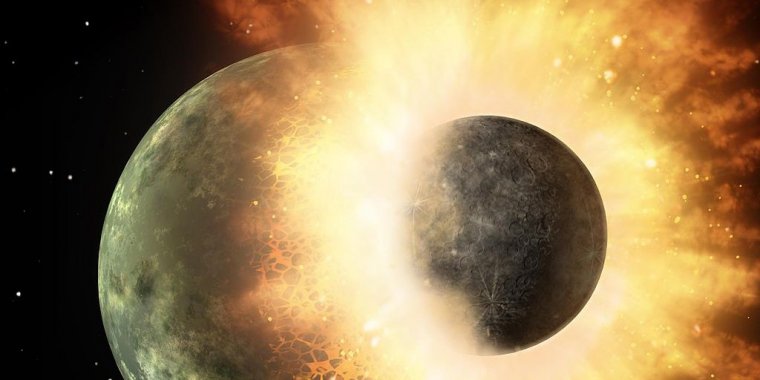| News / Science News |
Fiery Collisions That Gave Birth to Earth Could Have Evaporated 40% of Our World
The ground under your feet was not always so firm. Earth is thought to have gradually coalesced in fiery collisions of smaller planetoids – and those hellish conditions can now explain an enduring scientific mystery.

Artist's depiction of a collision between two planetary bodies. ![]()
"While it was previously known that building planets is a violent process and that the compositions of planets such as Earth are distinct, it was not clear that these features were linked," says geochemist Remco Hin from the University of Bristol in the UK.
Hin's team analyzed rocks from Earth using a mass spectrometer, and compared their chemical ingredients with off-world sources: meteorite chondrites (space rocks) plus samples from Mars and the asteroid Vesta.
According to the differing isotope ratios of the element magnesium in these samples – specifically, Earth and Mars have largely retained only the heavier forms of the chemical – substantial amounts of magnesium must have vaporized when the planets formed.
Running modelling to see how this magnesium (and other elements) could have vanished, the team calculated something almost unbelievable: up to 40 percent of the mass of Earth could have evaporated in repeated episodes of vaporization as the planet forged in fire.
In other words, hell on Earth was once very real – and it had some pretty severe consequences for a world-in-progress.
In a separate study, a team from Oxford University were investigating the same terrain from another perspective: why Earth is so depleted in moderately volatile elements (such as lead, zinc, and indium) compared to chondritic meteorites, which are thought to represent the chemical conditions of the early Solar System.
To find out, they constructed an artificial furnace designed to replicate the naturally occurring inferno during Earth's violent formation – melting rocks at 1,300°C (2,370 Fahrenheit) in oxygen-poor conditions.
Predictably enough, that intense heat caused the rocks to liquefy into molten lava, but once the lava cooled, analysis revealed that the chemical absences we find on Earth aren't an anomaly.
The experiments indicate that the pattern of volatile element depletion in the Earth was established by reaction between molten rock and an oxygen-poor atmosphere.
These reactions may have occurred on the early-formed planetesimals which were accreted to Earth or possibly during the giant impact which formed the Moon and which is believed to have caused large-scale melting of our planet.
These two different hypotheses on what may have happened in Earth's distant past can't be taken as confirmed proof of how things actually played out – but they offer a neat consistency in their explanations as to why Earth is the way it is, and other worlds too. (Tasnim News Agency)
YOU MAY ALSO LIKE



